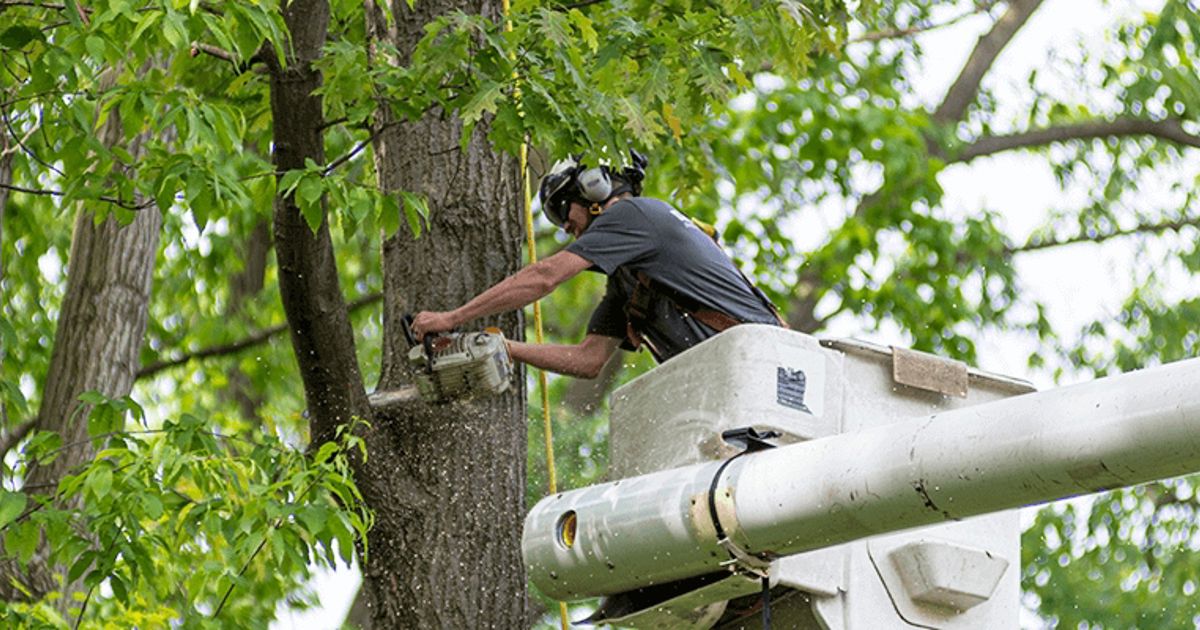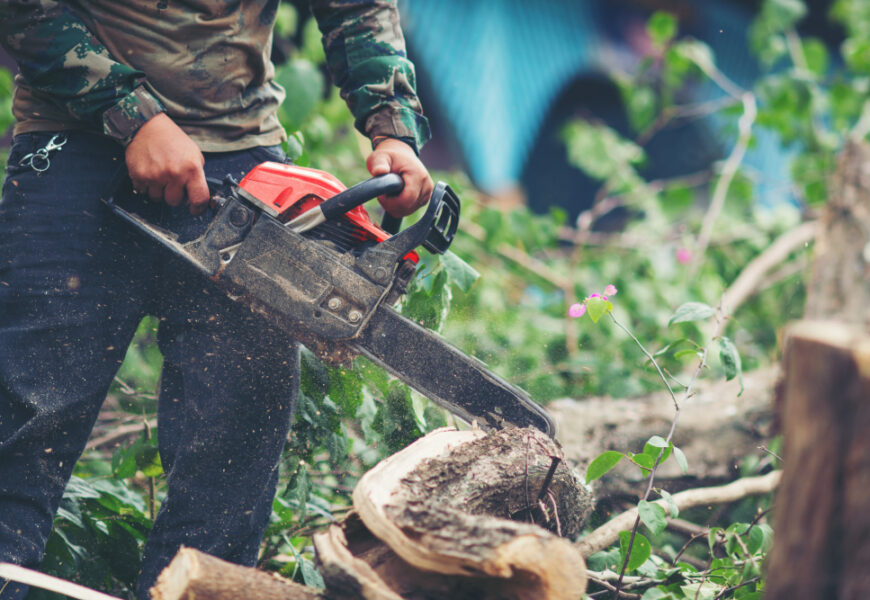Trees are parts of our environment, adding to the surroundings for us to enjoy shade, beauty, and shelter for wildlife. As we have seen with other living organisms, trees come to the end of their life. While some may live for decades or even centuries, others tend to die down due to diseases, weather conditions, and environmental factors that pose a threat to their health and safety. However, a dying or hazardous tree poses big threats to your property, personal security, and the entire surrounding environment. In this blog, we will discuss the top signs that your tree needs to go and when you should call in a professional to serve your Irving tree removal needs.
1. Dead or Dying Branches
The most common signs of distress in trees are dead or dying branches. These branches might look brittle, dry, or maybe just not have leaves at this time of year, and it may fall off easily. More than 50% dead or dying branches denote that this tree is sick and unlikely to recover. Deadwood is a severe hazard because it can break without warning, damaging property and injuring people.

What to do: Keep a regular eye on your tree for dead branches and seek advice from a certified arborist. They can advise you to chop away hazardous limbs or recommend that the entire tree be removed depending on the extent of the damage.
2. Visible Signs of Disease
Trees, like other plants, do undergo the effects of fungal, bacterial, or virus-related diseases. The most general symptoms attributed to tree diseases are yellowed leaves, abnormal growth types like cankers or galls, peeling bark, and fungi growth on the trunk or at the base of the tree. These symptoms usually imply the existence of internal decay or infection.

Professional tree removal in Irving may often uncover diseased trees with weakening roots due to various diseases like oak wilt, root rot, or Dutch elm disease. These can spread very rapidly to other trees around, making your landscape even more prone to failure.
What to do: If you notice any of the following warning signs, you should immediately call a tree professional. They can determine how serious the problem is, and whether or not you can treat the disease, or if the safe course of action would be to remove the tree would be determined.
3. Hollow Trunk
Hollow trunks are another sign that it may be time to cut a tree. Even though some trees with hollow trunks live for many years, their structural integrity is compromised, and this leaves the chance of its falling especially during strong winds or storms. The degree of hollowness and the size of the tree define if the tree can fall.

What to do: An arborist can assess how bad the hollowing is and thereby assist you in determining whether a leaning tree can be saved or if it should be removed.
4. Leaning Tree
While some trees slightly lean, any sudden change or significant tilt represents a red flag. A tree leaning dramatically over, especially after a storm or heavy wind, could indicate that the root system of the tree has been compromised. When the roots of a tree become damaged or weakened, it falls easily and causes severe damage to your properties as well as serious injuries.

What to do: When you notice that a tree in your yard is leaning more than usual, you have to act fast. Irving tree removal experts further advise the prompt removal of trees whose root system has been compromised prior to becoming a significant safety hazard.
5. Root Damage
The tree root anchors the tree to the ground and also gives the tree water and nutrients. It is usually harder to notice damage to the root system since it is underground, but some common causes may include construction or excavation or soil compaction near the tree. Some of the symptoms of damage in the root system include poorly growing trees with shallow or exposed roots, tilting, or leaning.
What to do: Observe the surroundings for any root disturbance or damage. If you suspect root damage, an arborist should conduct a thorough inspection and make recommendations, including possible removal.
6. Pest Infestation
Trees may become infested by insects and pests like termites, borers, or beetles. Some signs of infestation are holes in the bark and sawdust around the base, and even the activity of woodpeckers who enjoy the insects living inside. Pests affect the integrity of the tree structure, commonly leading to decay and death.
What to do: If you suspect there is a pest problem, deal with the issue immediately. Sometimes, treatments can be done to save the tree, but once it is advanced, removal may be the only safe solution.
7. Excessive Leaning After a Storm
An extreme storm can dramatically change the condition of a tree. After extreme weather, take an opportunity to examine your trees for signs of storm damage. Trees that have been uprooted or are dramatically leaning after a storm are quite hazardous. Thirdly, trees with cracked trunks or large broken limbs are a liability and may fall in the next gust of wind.
What to do: You can quickly receive an evaluation from a tree removal professional in Irving when the tree has storm damage. The decision that may follow is whether your tree is safe to continue with or will end up threatening your property. Err on the side of caution: the better approach in storm-damaged trees.
8. The tree is Too Close to the Structures
In some cases, an otherwise healthy tree might be problematic if it is located too close to structures on your property, such as a home, power lines, or other buildings. Trees, even healthy ones, can have adverse interactions with foundations, roofing, or utilities as they mature by way of branches and roots. Such situations may create hazardous proximity to your tree, especially in a storm.
Do: If your tree is encroaching into a portion of your house or other buildings, you should see the arborist to explain how best to solve the problem. Sometimes, strategic pruning will be enough to correct the problem, but if there is an obvious danger presented by your tree’s location, removal might be your only choice.
9. Tree Produces Hazard Debris
Some trees grow naturally in such a way that they shed big branches, nuts, or fruits everywhere in your lawn or even endanger you. Whereas this might be part of the life cycle of a tree, these are the ones continually dropping dangerous debris and may prove to be more of a hassle than they are worth.
What to do: If your tree regularly litters your yard with large limbs or hazardous material, it might be time to take it out. Replacing it with a species that has a better fit with your landscape could improve both safety and aesthetics.
10. Overgrown Canopy
A dense canopy can become problematic not just to the tree itself but also to the surrounding space. When it gets too thick, then those inner branches would not get enough light or air and cause decay in the inside. Overgrown branches, particularly very overgrown ones, tend to damage adjacent structures while blocking views or walkways.
What to Do: If the canopy of the tree is too big for the space, a certified arborist can assess if the tree requires trimming or if removal would be the best long-term solution.
When To Call For Irving Tree Removal
If you have seen any of the given signs appearing on your trees, it might be high time for you to call in professional removal services. A tree specialist assesses and considers which course of action would best guarantee the safety and health of a tree. Irving tree removal professionals are trained to take down hazardous trees without posing any danger to your property and surroundings.
Being proactive in recognizing early warning signs of a failing tree can save you money and ensure your home and family are safe. Don’t dismiss these important warnings—take action before it is too late!
Why Choose J. Chavez Tree Service for Your Tree Care Needs
Keeping your trees healthy and safe is a significant issue. Choosing experts who know what they are doing might be a good idea. Here at Chavez Tree Service, we have some of the best Irving tree services to meet all your tree care needs, from expert appraisals to safe removals. Their team consists of licensed arborists with diligence and efforts in keeping your trees healthy while moderating the risks facing your property. So whether it is maintenance, disease management, or emergency tree removal, J. Chavez Tree Service has the necessary competence and equipment to get it done. Due to its quality and commitment to customer satisfaction, it can be very trusted with keeping your landscape safe, attractive, as well as looking great.
Conclusion
Trees are a very valuable amenity in any landscape, but sometimes, when trees are no longer healthy or structurally sound, they become liabilities. Therefore, be alert to symptoms of decline, and never hesitate to call upon a tree service professional when you are unsure. You will avoid the dangers a compromised tree presents through proper care and timely removal.










